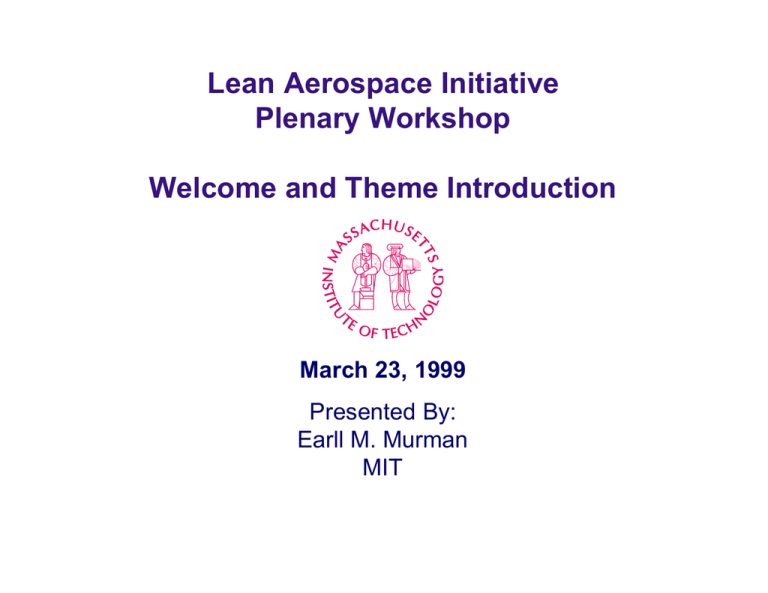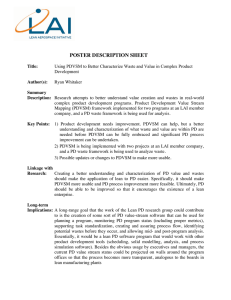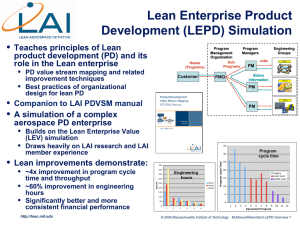Lean Aerospace Initiative: Lean Implementation & Benefits
advertisement

Lean Aerospace Initiative Plenary Workshop Welcome and Theme Introduction March 23, 1999 Presented By: Earll M. Murman MIT Lean Aerospace Initiative Presentation Outline l Introduction to LAI l Impact of lean and the benefits of LAI l A framework for the future l Workshop overview l Summary PM Murman 032399-2 ©1999 Massachusetts Institute of Technology Lean Aerospace Initiative LAI Sponsors and Participants Avionics/Missiles Space Applied Materials Inc. Hewlett Packard Raytheon Systems Co. (Dallas and El Segundo) Lockheed Martin Electronics & Missiles Textron Systems Division Rockwell Collins, Inc. TRW Inc. Lockheed Martin Space & Strategic Missiles Boeing Space Transportation Pratt & Whitney Space Propulsion Hughes Space & Communications GenCorp Aerojet TRW Inc. Airframe Propulsion The Boeing Company (St. Louis, Seattle) Lockheed Martin Aeronautical Systems Northrop Grumman Corp. Raytheon Aircraft Co. Other Government DARPA DLA NASA NAVAIR AMCOM OUSD(A&T) NRO Rolls Royce Allison General Electric Aircraft Engines Pratt & Whitney Gov’t Engines Sundstrand Corp. MIT • Lead Researchers Faculty, staff Students • Neutral Catalyst Other Participants US Air Force Aeronautical Systems Center Air Force Research Laboratory (Materials and Manufacturing Directorate) Space and Missile Center SPOS: JSF, F-22, C-17, Training (JPATS) UAW AIA DSMC IDA Wharton (Univ of Penn) Univ of Chicago International Collaborations: Univ of Linköping UK LAI 50/50 50/50Cost CostShare Sharebetween betweenGovernment Government&&Industry: Industry:Total Total$3.2M/yr. $3.2M/yr. PM Murman 032399-3 ©1999 Massachusetts Institute of Technology Lean Aerospace Initiative Lean Aerospace Initiative History 1993 - 1996 Consortium formed with industry/government/labor/MIT Focus on defense aircraft Research on benchmarking best practices Lean Enterprise Model (LEM) conceptualized Industrial base pilot projects started to accelerate improvement 1996 - 1999 Government membership expanded and Space Sector added Research on improving practices Collaboration with international programs initiated Focus on products; e.g. LEM, policy recommendations Impact of lean and LAI on industry/government assessed 1999 - 2002 Planning for LAI Phase III in progress Focus on “Best Life Cycle Value” and five key themes Address barriers to implementation and transition to lean Enhance effectiveness of the national workforce Emphasize knowledge deployment PM Murman 032399-4 ©1999 Massachusetts Institute of Technology Lean Aerospace Initiative LAI’s Process Flow Industry,Labor Government Research Priorities Experience Implementation MIT Imperative Drivers: Economic Realities [ Leadership Research Data Awareness Products LAI’s laboratory is the real world! PM Murman 032399-5 ©1999 Massachusetts Institute of Technology Lean Aerospace Initiative Current LAI Research and Products (Detailed write ups for each research project in tab 15 of binders) Product Development Test and Space Ops Supplier Relations • Req’ts gen/System eng • Lean S/C testing • Info infrastructure • Risk and variability • Lean launch ops • Strategic outsourcing • Technology insertion • Lean on-orbit ops • Supplier integration • PD value stream Factory Ops • Lean production system design • Benchmarking assembly systems • Transition to production • Benchmarking LAI Products Policy & External Environment Workshops Implementation Aids • Incentives for lean Lean Enterprise Model Policy Recommendations Reports/briefings/articles • Lean user req’ts • Subsystem commonality • Lean overhead s Integ c i p rated To PM Murman 032399-6 ©1999 Massachusetts Institute of Technology Lean Aerospace Initiative l Key LAI Events Since Last Plenary 13 Nov LAI Executive Board – Approved Prof. Widnall as Co-Chair representing MIT – Approved adding a MIT LAI stakeholder Co-Director – Cliff Harris was selected and joined LAI in Jan 1999 – Approved making LEM architecture (practices, metrics, definitions, but not data sheets) publicly available 1Q 99 – Approved preliminary plans for Phase III l 19-20 Jan Product Development Workshop – Product Development Value Stream l 3-4 Feb Implementation Workshop – System Barriers to Implementation l 18 Feb Supplier Relations Symposium – Electronic Integration of the Lean Enterprise Supplier Value Stream PM Murman 032399-7 ©1999 Massachusetts Institute of Technology Lean Aerospace Initiative l l l l l l External Events Since Last Plenary 8 Nov article in Dallas Morning News 10 Nov Presentation to SecAF Space Conference 1-4 Dec Defense Manufacturing Conference 15 Jan meeting with IAM representatives Feb Regional supplier workshop at the California Manufacturing Technology Center, Los Angeles 3 Mar Co-Chair briefing to Gen. Babbitt, AFMC/CC 5 Mar Co-Chair briefing to Dr. Gansler, OUSD (A&T) – Briefed “Impact of lean and benefits of LAI” l l 9 Mar article in NY Times business section 11 Mar briefing to Business Executives for National Defense PM Murman 032399-8 ©1999 Massachusetts Institute of Technology Lean Aerospace Initiative Impact of Lean and Benefits of LAI “What “What are are the the benefits benefits which which have have been been realized realized from from implementation implementation of of lean lean practices practices in in your your organization, organization, with with an an emphasis emphasis on on specific specific and and quantitative quantitative results” results” “What “What are are the the contributions contributions of of the the LAI LAI to to achieving achieving these these benefits” benefits” l l l 28 Letters received from LAI Executive Board members (16 industry, 11 government, MIT) White paper on web page and in back pocket of binders Briefed to Gen. Babbitt and Dr. Gansler PM Murman 032399-9 ©1999 Massachusetts Institute of Technology Lean Aerospace Initiative Impact of Lean on Stakeholders LAI LAI 16 16endorsement endorsement letters lettersfrom fromindustry industry LAI LAI 11 11endorsement endorsement letters lettersfrom from Government Governmentagencies agencies Substantial improvements in manufacturing efficiency Beginning to impact lower tier supply base and SPO organizations Opportunity to increase impact in • Product development • Business processes • Acquisition Source: “Benefits of Implementing Lean Practices and the Impact of the Lean Aerospace Initiative in the Defense Aerospace Industry and Government Agencies”, LAI White Paper, January 31, 1999 PM Murman 032399-10 ©1999 Massachusetts Institute of Technology Lean Aerospace Initiative Selected Examples of Impact of Lean in the Product Value Stream Up to 60% Reduction in Floor Space with Same Capacity > 60% Manufacturing Productivity Improvements Manufacturing 35% Overall Production Operations Productivity Improvements 40% Supplier Lead-time Reduction Opportunity Supplier Integration 30% Reductions in Product Development costs demonstrated in pilot projects Product Development Acquisition System & Policy Source: “Benefits of Implementing Lean Practices and the Impact of the Lean Aerospace Initiative in the Defense Aerospace Industry and Government Agencies”, LAI White Paper, January 31, 1999 PM Murman 032399-11 ©1999 Massachusetts Institute of Technology Lean Aerospace Initiative Lean Implementation and Opportunities in Product Value Stream Lean Leaders % Implementation* Lean Lean“converts” “converts” are arejust justbeginning beginning to torealize realizethe the benefits benefits 25-40% Manufacturing 20-30% Supplier Integration 15-20% Product Development 2-10% Business Processes <10% Acquisition Interface *LAI Integration Team Assessment PM Murman 032399-12 ©1999 Massachusetts Institute of Technology Customer Practices & Policies Lean Business Practices • Strong Integrated Product Teams proponent • Shared metrics and data • Creative Incentives – Separate contracts to provide insight (delivery, affordability, support) Production Efficiency P-24 P-33 P-41 Headcount ASSEMBLY PERFORMANCE (% efficiency) Incentives for Lean Behavior on C-17 ACTUAL HEADCOUNT Lean Aerospace Initiative Results Deliveries ahead of schedule Production efficiency up 50% Nonconformance hours down 70% – Award fee for each contract tied to complementary goals and measures Nonconformance Hours – Unique incentives in multi-year contract (e.g. sell place in line if FMS opportunities arise) 0 Source: C-17 SPO PM Murman 032399-13 ©1999 Massachusetts Institute of Technology Lean Aerospace Initiative Pilot & Demonstration Projects MODULAR FACTORY FOR ELECTRONIC WARFARE COMPONENT MFG (CEC Program, ALQ-135) 50% reduction in microwave power module (MPM) costs To Date: • 16 Lean Forum projects initiated • Linked to LAI research findings ADVANCED MODULAR • $96M invested, MISSILE FACTORY ManTech & SPO 40% reduction in AMRAAM cycle Examples • 2:1 return time, 25% plant-wide inventory documented reduction • All projects tied to a weapon system sponsor (JSF, FC-17 LEAN FACTORY $18M Price Reduction on Main 22, C-17, AIM-120) Landing Gear Pod and Cargo to insure Door implementation s ! e iv t t Me c e y j d b O ea Al r Source: ManTech PM Murman 032399-14 ©1999 Massachusetts Institute of Technology Lean Aerospace Initiative l l l l Major Reported LAI Benefits Consortium-guided, university led research program evolving a knowledge base to support transitioning to lean Research products, e.g. the Lean Enterprise Model (LEM), provide reference tools for common awareness, language and understanding of lean principles Focus and framework for implementation Neutral forum for exchange of information, ideas, and understanding “Everyone “Everyonein inthe thedefense defenseestablishment establishmentshares sharesthe thebenefits benefitsof ofLAI. LAI. Through Throughmutual mutualcommitment commitmentto toimprovement, improvement,shared sharedknowledge knowledge,, and andleveraged leveragedimplementation implementation,,we wehave haveraised raisedthe thelevel levelof of competency competencyin inthe theUS USdefense defenseindustry industryand andfueled fueledthe theacquisition acquisition reform reformprocess.” process.”--Industry Industryletter letter Source: “Benefits of Implementing Lean Practices and the Impact of the Lean Aerospace Initiative in the Defense Aerospace Industry and Government Agencies”, LAI White Paper, January 31, 1999 PM Murman 032399-15 ©1999 Massachusetts Institute of Technology Lean Aerospace Initiative LAI Impact on Education Scholarship and Enhanced Educational Programs: “LAI aligns MIT closer to industry and government concerns.” l Faculty & graduate students in LAI engaged in real world problems addressing a national need l Graduating students placed in U.S. aerospace organizations l Collaboration between Engineering & Management Schools and faculty l Impact on degree programs and curriculum l A new academic model for collaboration with industry and government Source: “Benefits of Implementing Lean Practices and the Impact of the Lean Aerospace Initiative in the Defense Aerospace Industry and Government Agencies”, LAI White Paper, January 31, 1999 PM Murman 032399-16 ©1999 Massachusetts Institute of Technology Lean Aerospace Initiative A Framework For The Future Best Best Life Life Cycle Cycle Value Value A A system system offering offering best best life-cycle life-cycle value value is is defined defined as as aa system system introduced introduced at at the the right right time time and and right right price price which which delivers deliversbest best value value in in mission mission effectiveness, effectiveness, performance, performance, affordability affordability and and sustainability sustainability and and retains retains these these advantages advantages throughout throughout its its life life PM Murman 032399-17 ©1999 Massachusetts Institute of Technology Lean Aerospace Initiative l Five Enterprise Themes For “Best Life Cycle Value” Time as measured by cycle time and clock speeds – Shift to “economies of time” from “economies of scale” è Organization and people as essential to success – Related to largest number of LEM Overarching Practices è Knowledge & information infrastructures as enablers – Linkages for the lean enterprise value streams l Government as a lean customer and operator – Central driver in the pace of change to lean l Measuring the added value to the enterprise – Workforce, customers, shareholders, the public è Themes for this morning’s plenary speakers PM Murman 032399-18 ©1999 Massachusetts Institute of Technology Lean Aerospace Initiative Plenary Workshop Format Day One - Mar. 23 Day Two - Mar. 24 A.M. - General Session A.M. - General Session LAI Perspective: Tom Ferguson Keynote: Doug Engelbart Speaker: Tom Kochan Implementation Activities Lean Debate Coordination Strategies with Speakers : Marc Knez, Jan Summers, Sandy Jap Panel Discussion P.M. P.M. Focus Team Meetings Breakout Sessions 7 different topical areas Reception Reception Dinner PM Murman 032399-19 ©1999 Massachusetts Institute of Technology Lean Aerospace Initiative SCHEDULE Workshop Notes l Presentations are in your binders; also on our web site on or about April 4, 1999 l A Workshop Evaluation is also included l On-site business services 4th floor or limited assistance at LAI registration desk l Two scheduled breaks - please keep program running smoothly by adhering to times l Refer to Tab 1 for complete list of scheduled meetings and room assignments l Videotaping in progress to help extend learning and outreach l Reception with cash bar starting at 5:30 PM Murman 032399-20 ©1999 Massachusetts Institute of Technology Lean Aerospace Initiative Summary l LAI has evolved since 1993 to provide the knowledge base and implementation focus for transitioning the national defense aerospace enterprise to lean l Lean has demonstrated reduced cycle times and costs for military aerospace products, with improved performance l A focus for the future is “Best Life Cycle Value” with accompanying key enterprise themes l Welcome to the Spring 99 LAI Plenary Workshop PM Murman 032399-21 ©1999 Massachusetts Institute of Technology



